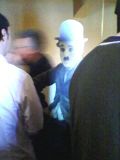 I was on the Berkeley campus Saturday evening for the 2nd of 3 programs given by the Vienna Philharmonic Orchestra. In his pre-concert lecture, Prof. Clemens Hellsberg, 1st violinist & Vienna Phil President, told us about the orchestra's collaborations with Schumann & Brahms, the composers on the program. Prof. Hellsberg also slipped in some dry humor along with many dry facts about the orchestra's history.
I was on the Berkeley campus Saturday evening for the 2nd of 3 programs given by the Vienna Philharmonic Orchestra. In his pre-concert lecture, Prof. Clemens Hellsberg, 1st violinist & Vienna Phil President, told us about the orchestra's collaborations with Schumann & Brahms, the composers on the program. Prof. Hellsberg also slipped in some dry humor along with many dry facts about the orchestra's history.The 2nd Schumann Symphony was performed with a slightly reduced, classical-sized orchestra. I've never heard the Vienna Phil before, so I was fascinated by its transparent string texture & the brilliant woodwind timbres, though a couple of brass hiccups in the opening measures dismayed me. The principal oboe has an unusually distinct sound, piercing, high, wide & reedy. The clarinet solo in the Adagio was beautifully clean & floaty & seemingly effortless. The orchestra's players are very animated & at times look unable to stay seated. The Scherzo felt barely kept in check & always just about to fall out of balance. The timpani made a wonderfully big, bloated roll in the finale. The audience applauded each movement except the Adagio.
The orchestra was full-sized for the Brahms 2. The horns were perfect in the opening, & there was a gorgeous horn solo, the instrument sounding smooth yet brassy. I was very happy whenever another oboe or clarinet solo popped out. The orchestra has great dynamic range, & the strings play with a taut energy. Conductor Semyon Bychkov led the entire program without a score. He always looked engaged with the music, but it was not clear to me by his gestures what his contributions were.
The orchestra ripped into Brahms's Hungarian Dance No. 5 as their encore. Suddenly the strings had a meaty, woody tone & the whole ensemble sounded twice as loud & twice as brilliant. Their intensity & exuberance startled & even frightened me a bit. They made the piece feel new & not over-familiar.
Of course Zellerbach was full for this event, & it was difficult to maneuver around the hall. I sat at the very back of the balcony, where I felt that a lot of the orchestra's sound was simply lost in the cave-like auditorium. There were several small children seated around me. During the performance I heard much whispering, & someone kept opening something made of velcro. A young couple in front of me was especially fidgety. They snacked, drank, whispered, pointed out things in the program to one another & even searched under their seats, all while the music was going on. I brought my binoculars specifically to count the number of women in the ensemble, & I spotted 6 throughout the evening.
§ Cal Performances
Vienna Philharmonic Orchestra
Semyon Bychkov, conductor
Schumann: Symphony No. 2
Brahms: Symphony No. 2
Encore: Brahms: Hungarian Dance No. 5
Sat, Feb 26, 8 pm
Zellerbach Hall











